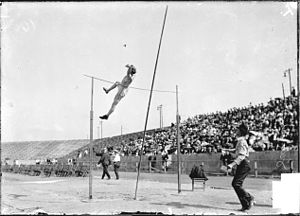1904 Summer Olympics / Athletics - Pole Vault (Men)
|
|
|||||||||

|
|||||||||
| sport | athletics | ||||||||
| discipline | Pole vault | ||||||||
| gender | Men | ||||||||
| Attendees | 7 athletes from 2 countries | ||||||||
| Competition location | Francis Field | ||||||||
| Competition phase | September 3, 1904 | ||||||||
|
|||||||||
The men's pole vault at the 1904 Olympic Games in St. Louis was held on September 3, 1904 at Francis Field .
The US team celebrated a triple success. The winner was Charles Dvorak , LeRoy Samse won the silver medal. Louis Wilkins won bronze.
Records
The world records that existed at the time were still unofficial.
| World record | 3.69 m |
|
Norman Dole | Oakland ( USA ) April 23, 1994 |
|---|---|---|---|---|
|
|
Fernand Gonder | Paris ( FRA ), June 26, 1904 | ||
| Olympic record | 3.30 m |
|
William Hoyt | Final of Athens ( GRE ), April 10, 1896 |
|
|
Irving Baxter | Paris finals ( FRA ), July 15, 1900 |
The following records were broken or set in the pole vault at these Olympic Games:
| OR | 3.505 m |
|
Charles Dvorak |
Result
Result according to Kluge - SportsReference
|
Result to the Megede - IOC page
|
Charles Dvorak was the first pole vaulter to use bamboo sticks instead of the usual ash or hickory wood. After he was established as the Olympic champion, he tried his hand at the new world record of 3.71 m, but failed in three attempts. After being one of the favorites four years earlier because of the annoying Sunday problem , which led to numerous athletes not taking part in competitions on Sundays for religious reasons, Dvorak made up for what he had missed here in St. Louis won Olympic gold. Not among the participants in these games was the French co-owner of the world record Fernand Gonder , who might have been a serious competitor for Charles Dvorak.
The most likely variant of the other placements can be found in the representation described in SportsReference . The corresponding list of results corresponds to the list at Kluge . The results at zur Megede and on the IOC website differ. There, however, everything indicates that apparently no distinction was made between the main competition and the jump-off, which would explain the differences. However, the difference in the ranking for places five and six cannot be explained. That has to remain open here and can only be compared, as is done in the tables above. In the following the representation with stabbing fights as with SportsReference is described.
Louis Wilkins, LeRoy Samse, Claude Allen and Ward McLanahan had each traversed 3.35 m. There was no failed attempt or multiple attempt rule, so the decision had to be made in a jump-off. Here Allen and McLanahan only managed 3.275 m, while Wilkins and Samse jumped 3.43 m. The decision between the two jumpers at the same height was then made in a second series of play-offs, the performances of which are not recorded.
literature
- Volker Kluge , Olympic Summer Games - The Chronicle I, Berlin 1997 ( ISBN 3-328-00715-6 )
- Ekkehard zur Megede , The history of Olympic athletics, Volume 1: 1896–1936, Verlag Bartels & Wernitz KG, Berlin, 2nd edition 1970
Web links
- Sports-Reference, Athletics at the 1904 St. Louis Summer Games: Men's Pole Vault , accessed August 2, 2018
- Olympic Games St. Louis 1904, Athletics, pole vault men , IOC page on athletics at the 1904 Olympic Games at olympic.org, English, accessed August 2, 2018
Individual evidence
- ↑ Ekkehard zur Megede , The History of Olympic Athletics, Volume 1: 1896–1936, Verlag Bartels & Wernitz KG, Berlin, 2nd edition 1970, p. 55






